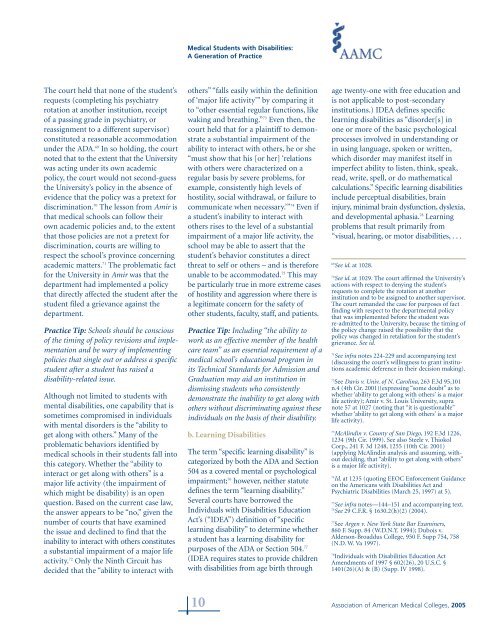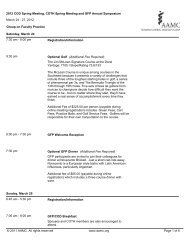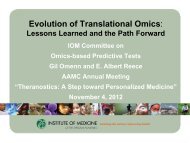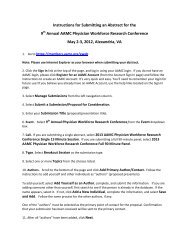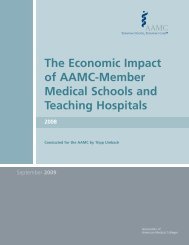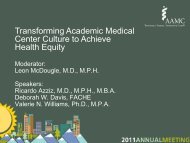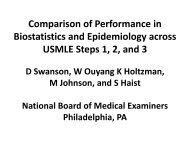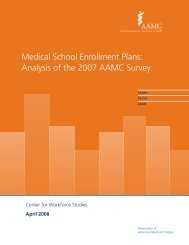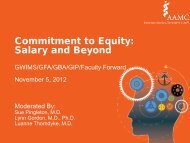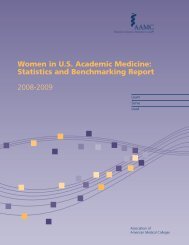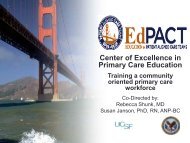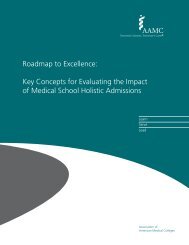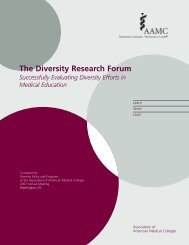Medical Students with Disabilities: A Generation of Practice
Medical Students with Disabilities: A Generation of Practice
Medical Students with Disabilities: A Generation of Practice
You also want an ePaper? Increase the reach of your titles
YUMPU automatically turns print PDFs into web optimized ePapers that Google loves.
<strong>Medical</strong> <strong>Students</strong> <strong>with</strong> <strong>Disabilities</strong>:<br />
A <strong>Generation</strong> <strong>of</strong> <strong>Practice</strong><br />
The court held that none <strong>of</strong> the student’s<br />
requests (completing his psychiatry<br />
rotation at another institution, receipt<br />
<strong>of</strong> a passing grade in psychiatry, or<br />
reassignment to a different supervisor)<br />
constituted a reasonable accommodation<br />
under the ADA. 69 In so holding, the court<br />
noted that to the extent that the University<br />
was acting under its own academic<br />
policy, the court would not second-guess<br />
the University’s policy in the absence <strong>of</strong><br />
evidence that the policy was a pretext for<br />
discrimination. 70 The lesson from Amir is<br />
that medical schools can follow their<br />
own academic policies and, to the extent<br />
that those policies are not a pretext for<br />
discrimination, courts are willing to<br />
respect the school’s province concerning<br />
academic matters. 71 The problematic fact<br />
for the University in Amir was that the<br />
department had implemented a policy<br />
that directly affected the student after the<br />
student filed a grievance against the<br />
department.<br />
<strong>Practice</strong> Tip: Schools should be conscious<br />
<strong>of</strong> the timing <strong>of</strong> policy revisions and implementation<br />
and be wary <strong>of</strong> implementing<br />
policies that single out or address a specific<br />
student after a student has raised a<br />
disability-related issue.<br />
Although not limited to students <strong>with</strong><br />
mental disabilities, one capability that is<br />
sometimes compromised in individuals<br />
<strong>with</strong> mental disorders is the “ability to<br />
get along <strong>with</strong> others.” Many <strong>of</strong> the<br />
problematic behaviors identified by<br />
medical schools in their students fall into<br />
this category. Whether the “ability to<br />
interact or get along <strong>with</strong> others” is a<br />
major life activity (the impairment <strong>of</strong><br />
which might be disability) is an open<br />
question. Based on the current case law,<br />
the answer appears to be “no,” given the<br />
number <strong>of</strong> courts that have examined<br />
the issue and declined to find that the<br />
inability to interact <strong>with</strong> others constitutes<br />
a substantial impairment <strong>of</strong> a major life<br />
activity. 72 Only the Ninth Circuit has<br />
decided that the “ability to interact <strong>with</strong><br />
others” “falls easily <strong>with</strong>in the definition<br />
<strong>of</strong> ‘major life activity’” by comparing it<br />
to “other essential regular functions, like<br />
waking and breathing.” 73 Even then, the<br />
court held that for a plaintiff to demonstrate<br />
a substantial impairment <strong>of</strong> the<br />
ability to interact <strong>with</strong> others, he or she<br />
“must show that his [or her] ‘relations<br />
<strong>with</strong> others were characterized on a<br />
regular basis by severe problems, for<br />
example, consistently high levels <strong>of</strong><br />
hostility, social <strong>with</strong>drawal, or failure to<br />
communicate when necessary.’” 74 Even if<br />
a student’s inability to interact <strong>with</strong><br />
others rises to the level <strong>of</strong> a substantial<br />
impairment <strong>of</strong> a major life activity, the<br />
school may be able to assert that the<br />
student’s behavior constitutes a direct<br />
threat to self or others – and is therefore<br />
unable to be accommodated. 75 This may<br />
be particularly true in more extreme cases<br />
<strong>of</strong> hostility and aggression where there is<br />
a legitimate concern for the safety <strong>of</strong><br />
other students, faculty, staff, and patients.<br />
<strong>Practice</strong> Tip: Including “the ability to<br />
work as an effective member <strong>of</strong> the health<br />
care team” as an essential requirement <strong>of</strong> a<br />
medical school’s educational program in<br />
its Technical Standards for Admission and<br />
Graduation may aid an institution in<br />
dismissing students who consistently<br />
demonstrate the inability to get along <strong>with</strong><br />
others <strong>with</strong>out discriminating against these<br />
individuals on the basis <strong>of</strong> their disability.<br />
b. Learning <strong>Disabilities</strong><br />
The term “specific learning disability” is<br />
categorized by both the ADA and Section<br />
504 as a covered mental or psychological<br />
impairment; 76 however, neither statute<br />
defines the term “learning disability.”<br />
Several courts have borrowed the<br />
Individuals <strong>with</strong> <strong>Disabilities</strong> Education<br />
Act’s (“IDEA”) definition <strong>of</strong> “specific<br />
learning disability” to determine whether<br />
a student has a learning disability for<br />
purposes <strong>of</strong> the ADA or Section 504. 77<br />
(IDEA requires states to provide children<br />
<strong>with</strong> disabilities from age birth through<br />
age twenty-one <strong>with</strong> free education and<br />
is not applicable to post-secondary<br />
institutions.) IDEA defines specific<br />
learning disabilities as “disorder[s] in<br />
one or more <strong>of</strong> the basic psychological<br />
processes involved in understanding or<br />
in using language, spoken or written,<br />
which disorder may manifest itself in<br />
imperfect ability to listen, think, speak,<br />
read, write, spell, or do mathematical<br />
calculations.” Specific learning disabilities<br />
include perceptual disabilities, brain<br />
injury, minimal brain dysfunction, dyslexia,<br />
and developmental aphasia. 78 Learning<br />
problems that result primarily from<br />
“visual, hearing, or motor disabilities, . . .<br />
69<br />
See id. at 1028.<br />
70<br />
See id. at 1029. The court affirmed the University’s<br />
actions <strong>with</strong> respect to denying the student’s<br />
requests to complete the rotation at another<br />
institution and to be assigned to another supervisor.<br />
The court remanded the case for purposes <strong>of</strong> fact<br />
finding <strong>with</strong> respect to the departmental policy<br />
that was implemented before the student was<br />
re-admitted to the University, because the timing <strong>of</strong><br />
the policy change raised the possibility that the<br />
policy was changed in retaliation for the student’s<br />
grievance. See id.<br />
71<br />
See infra notes 224-229 and accompanying text<br />
(discussing the court’s willingness to grant institutions<br />
academic deference in their decision making).<br />
72<br />
See Davis v. Univ. <strong>of</strong> N. Carolina, 263 F.3d 95,101<br />
n.4 (4th Cir. 2001)(expressing “some doubt” as to<br />
whether ‘ability to get along <strong>with</strong> others’ is a major<br />
life activity); Amir v. St. Louis University, supra<br />
note 57 at 1027 (noting that “it is questionable”<br />
whether ‘ability to get along <strong>with</strong> others’ is a major<br />
life activity).<br />
73<br />
McAlindin v. County <strong>of</strong> San Diego, 192 F.3d 1226,<br />
1234 (9th Cir. 1999). See also Steele v. Thiokol<br />
Corp., 241 F. 3d 1248, 1255 (10th Cir. 2001)<br />
(applying McAlindin analysis and assuming, <strong>with</strong>out<br />
deciding, that “ability to get along <strong>with</strong> others”<br />
is a major life activity).<br />
74<br />
Id. at 1235 (quoting EEOC Enforcement Guidance<br />
on the Americans <strong>with</strong> <strong>Disabilities</strong> Act and<br />
Psychiatric <strong>Disabilities</strong> (March 25, 1997) at 5).<br />
75<br />
See infra notes—144–151 and accompanying text.<br />
76<br />
See 29 C.F.R. § 1630.2(h)(2) (2004).<br />
77<br />
See Argen v. New York State Bar Examiners,<br />
860 F. Supp. 84 (W.D.N.Y. 1994); Dubois v.<br />
Alderson-Broaddus College, 950 F. Supp 754, 758<br />
(N.D. W. Va 1997).<br />
78<br />
Individuals <strong>with</strong> <strong>Disabilities</strong> Education Act<br />
Amendments <strong>of</strong> 1997 § 602(26), 20 U.S.C. §<br />
1401(26)(A) & (B) (Supp. IV 1998).<br />
10 Association <strong>of</strong> American <strong>Medical</strong> Colleges, 2005


